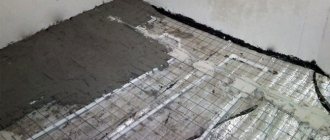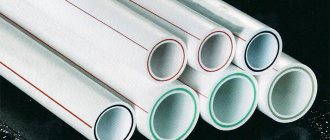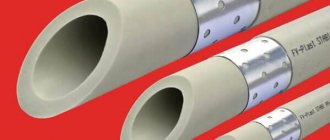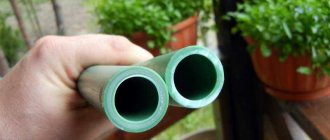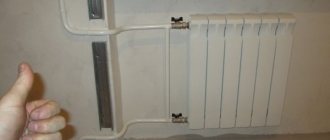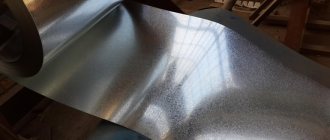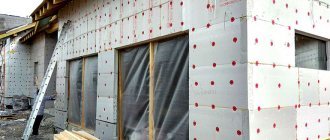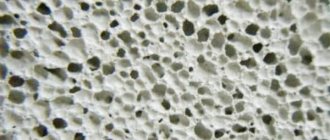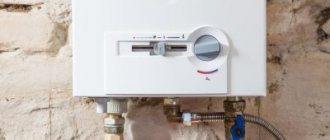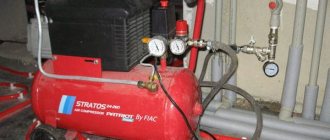In what places should polypropylene pipes be insulated?
Polymer pipes have a number of significant advantages over conventional steel analogues, and therefore are used very widely in the creation or modernization of aquifer networks. Polypropylene pipelines located inside a building, as a rule, rarely require insulation, with the exception of a few cases.
Insulation of polypropylene pipes is mandatory if they are located:
- Under the floors of the first floors, if they are above the ground or dug to a depth of less than 1 meter.
- In rooms of floors and buildings in which there is no heating.
- In unheated extensions: verandas, terraces, etc.
This is done to prevent the possibility of water freezing. In severe frosts at night, when there is practically no circulation in the system, the liquid can turn into ice.
Sometimes it is recommended to insulate the risers of hot water and heating pipes. However, this is done to obtain the opposite effect, that is, to reduce heat leakage, and is an optional condition.
In other places inside a heated building, insulation of polypropylene pipes is not required.
How to insulate polypropylene pipes
The sequence of actions practically coincides with the insulation of metal pipes. If you use glass wool as insulation, you cannot start work without protective gloves. Auxiliary tools in this case will not be useful if you use ready-made sleeves made of glass wool or glass wool (Germany). Today, such insulation for polypropylene pipes is practically not in demand; it has been replaced by other materials in the form of liquid ceramics, synthetics and ceramic fiber hoses. FUM tape is often used on seals and butt joints.
You can also use a special anti-condensation material as a heat insulator, which must be applied several times to all pipe bends, connections and turns. Thus, all pipeline elements will be isolated from outside influences and completely sealed. Your polypropylene heating pipes will be guaranteed to be protected from delamination and temperature fluctuations in the walls.
If the heating system is walled into the wall, and it warms up the entire space around it, then is it necessary to additionally insulate the polypropylene pipes? It turns out yes.
And there are several reasons for this:
- Thanks to additional sealing, it is possible to delay the process of heat leakage due to a pipe rupture.
- With a significant range of temperatures outside and inside the tubular product, the process of its cooling is accelerated, etc.
That is, in practice it has been proven that the benefits of insulating and sealing polypropylene pipes are enormous. It is better, of course, to use the highest quality materials, among which foamed polyethylene occupies a leading position (for more details: “How to choose insulation for pipes made of foamed polyethylene - characteristics of the insulating material”). With its help, the thermal insulation of the pipe is carried out quite quickly, you just need to press the balloon piston.
What is condensation on utility networks and what to do with it
Condensation is the deposition of moisture from the air on cold objects. A similar phenomenon can be observed in a hot bath. When in contact with cold walls, water vapor passes from a gaseous state to a liquid state, and then collects (condenses) on the surface in the form of drops. The same thing, but in slow motion, happens with the metal elements of the cold water supply system. Since steel is an excellent conductor of heat, the temperature of the outer surfaces of the pipes is equal to the temperature of the cold water passing through them. It is much lower than the temperature of the surrounding air and the water vapor present in it, especially if a pipe with hot water passes nearby. This difference causes condensation to form.
Polypropylene has low thermal conductivity, so the outer surface of a cold water pipe made of this material cools less than that of a steel pipe. As a result, vapor condensation on polymer structures does not occur, or occurs in insignificant quantities. If moisture nevertheless condenses, it is enough to insulate such places with a thin layer of insulation - you can use hemispheres made of foamed polymer.
Purpose of thermal insulation
The creation of utilities from a polymer material guarantees insignificant heat loss, because polypropylene itself is a heat insulator. This nuance must always be remembered by homeowners when installing heating and hot water supply systems.
Thermal insulation of pipelines
Generating thermal energy is not cheap. Therefore, to completely eliminate heat loss, even when installing PP systems, it is necessary to use thermal insulation materials. They will protect systems from temperature changes and interaction with aggressive environments.
Insulation for polypropylene pipes must be used on facilities built in areas with a continental climate. Indeed, temperature stress often occurs in such zones. It negatively affects the strength characteristics of products.
Thermal insulation of polymer pipe products is also performed to prevent the appearance of condensation on cold water systems. This process is the deposition of moisture from the air. In other words, water vapor turns into droplets on cooled surfaces.
However, condensation does not always form on polymer parts because they have low thermal conductivity. Even if there is the slightest risk of water droplets appearing on the surface of the pipelines, insulation must be used.
It is also used if there is a possibility of the system freezing. Thermal insulation will protect communications from the cold.
The use of insulating material prevents:
- the appearance of ice plugs;
- negative mechanical impacts leading to wear and tear of communications;
- regular freezing of liquid in pipelines, which can cause cracks due to expansion of the moving medium.
Insulation is also used to prevent delamination of PP products. This can happen due to the difference in temperature between the outer and inner layers. Indeed, in cold places, the surface of areas of heating and hot water systems cools down greatly, but inside they remain hot.
Pipelines must be insulated with thermal insulation whose coefficient of thermal expansion coincides with the same characteristic of the protected products. This parameter can be found in the technical data sheet for the pipes.
Glass wool and mineral materials
One of the popular and long-used thermal insulators is glass wool. This is a mineral material with which you can protect any communications, including heating, plumbing and air conditioning lines.
Glass wool pipe insulation
The principle of operation of glass wool resembles a thermos. In other words, the heated medium remains hot, but the temperature of the cold substance does not increase. Fibrous insulation material prevents heat transfer. Mineral insulation also allows you to move the dew point.
Therefore, condensation does not appear on utility lines. In addition, glass wool has good vibration-absorbing and sound-proofing properties.
Mineral heat insulator is used:
- indoors;
- during the installation of engineering systems in the soil;
- during ground installation of communications.
Manufacturers produce glass wool in the form of cylinders, mats, slabs and rolls. The usual insulation thickness is 50-150 mm. Glass wool is used immediately after pipe installation.
Foamed polyethylene
This insulation for polypropylene pipes has a structure consisting of the smallest cells of a closed structure. In most cases, the density of the material is between 30 and 35 kg/m3.
Thermal insulation for pipes made of foamed polyethylene
The heat insulator has excellent elasticity. Therefore, thermal insulation made of foamed polyethylene is easily mounted on pipelines.
This type of insulation is produced using extrusion and by directly foaming high-density polyethylene. The initial raw materials and manufacturing method make it possible to obtain a heat insulator with unique physicochemical properties.
The most important of them is the high thermal insulation ability. Durability, resistance to wet environments and increased strength. However, the insulation is highly flammable. Manufacturers produce foamed polyethylene in the form of tubes with a side cut, sheets and even bundles.
Foam plastic (expanded polystyrene)
This type of heat insulator is available in the form of a shell. The insulation has higher rigidity compared to foamed polyethylene. The structure of the material consists of a large number of closed cells. Thanks to this, polystyrene foam is highly resistant to moisture.
Pipe insulation with foam plastic
Many manufacturers make foam shells that have a locking design. They close through a tongue-and-groove system.
This material is a highly flammable insulation material. Moreover, rodents like it. Therefore, it is better to use a heat insulator in a place where there are no such mammals.
Polystyrene foam is a lightweight material. Its weight directly depends on the specific density. There is extruded polystyrene foam. It is characterized by higher resistance to mechanical damage and strength.
Extruded polystyrene foam is suitable for insulating communications laid in the soil.
Polyurethane foam
This is another type of popular polypropylene pipe insulation. Thermal insulation is similar in appearance to polystyrene foam.
Thermal insulation of pipes with polyurethane foam
Polyurethane foam has the following advantages:
- low thermal conductivity;
- good moisture and vapor resistance, which allows the use of insulation on external pipelines;
- low weight for easy installation;
- durability, which can reach 50 years.
Mold and even mildew do not appear on polyurethane foam. The material is not of interest to rodents. Thermal insulator is most often produced in the form of shells. Manufacturers produce polyurethane foam with a two-component composition.
Its installation is carried out using special equipment that allows the material to be sprayed. This subtype of heat insulator is perfect for protecting large-diameter systems.
The disadvantages of polyurethane foam include instability in the sun. When exposed to them, the insulation is destroyed. To reduce this effect, it is recommended to cover the thermal insulation with protective material. The insulation can also be coated with paint.
Why is it sometimes necessary to insulate some parts of the water supply?
In places (described above) where the water supply is at risk of being frozen, it is necessary to protect polypropylene pipes from the cold. Polymers have significant elasticity and tensile strength, so water expanding when freezing does not lead to rupture of products. However, this does not mean that such parts of the water supply system do not need to be insulated. Causes:
- The resulting ice plugs block the water flow, and the water supply stops functioning.
- Repeated mechanical impact on the material leads to its accelerated wear.
- If the water in the system constantly freezes, the pipes can still burst.
The outer parts of the water supply can be buried deeper in the ground, and for the internal sections thermal insulation for polypropylene or any other pipes is used. This can be mineral wool, polyurethane foam shell, polyethylene foam and other varieties.
polypropylene pipe Does a polypropylene pipe give off heat? Rating:
#1 km86
- Participant
- Group: Users
- Posts: 95
- Registration: 08 November 09
- From: r.p. Buturlino
- Weapon: MR-153
#2 max m
- Forum old-timer
- Group: Users
- Posts: 1,246
- Registration: 13 April 10
- Weapons: MR-153, MC 20-01, Benelli Argo 9.3x62
#3 Diman307
- Forum old-timer
- Group: Users
- Posts: 1,455
- Registration: 27 December 09
- From: N. Novgorod.
- Weapon: TOZ-91 Fabarm Axis MP-156
km86 (05 November 2012 – 12:41) wrote:
#4 Hunter-Samara
- Active participant
- Group: Users
- Posts: 222
- Registration: 21 March 12
- From: Samara
- Weapons: All kinds, assorted
#5 km86
- Participant
- Group: Users
- Posts: 95
- Registration: 08 November 09
- From: r.p. Buturlino
- Weapon: MR-153
Heating system and pipe insulation
It is not customary to cover the indoor heating system with thermal insulation; only parts of the centralized heating system running outside the building are insulated, which, in turn, is also very rare. If desired, you can insulate the risers, especially if they are located in utility rooms. This will reduce heat loss and increase the temperature of radiators in living rooms.
It is also advisable to cover sections of the system that run along recesses in the walls, foundation or concrete floor (grooves) with thermal insulation elements. This will eliminate the heating of adjacent areas and their thermal expansion, and will also create additional space around the pipes, which will compensate for the expansion of the system itself.
When using polypropylene products in a heating structure, you must remember that only reinforced pipes, for example, the ITAL brand, are suitable for these purposes. These products can withstand severe temperature changes (up to 95° C). In it, between two layers of polymer there is a layer of aluminum reinforcement, which provides increased strength and wear resistance.
Insulation of polypropylene hot water pipes. Features and Tips
Plastic pipes for domestic hot and cold water systems in buildings have been used for many years and have become the dominant material in residential construction. Thermal insulation of polypropylene hot water pipes must be carried out immediately after installation, before they are “sewn” into the walls. This will reduce the temperature drop in the internal and external wiring areas.
In what places should polypropylene pipes be insulated?
Compared to metal piping systems, plastic ones have significant advantages, which leads to lower heat transfer between the liquid and the surrounding air. Insulation of polypropylene pipes will help avoid heat loss and, accordingly, cooling of hot water by 15-20%. For example, foamed polyethylene has a thermal conductivity coefficient of 0.036 W/mK, and polypropylene has a coefficient of thermal conductivity of 0.027 W/mK. The difference is obvious - 25% of heat can be saved when using this material.
All plastic pipes are subject to insulation, starting from the basement to the internal wiring inside the room. If you live in a multi-storey building with a technical floor (attic), then insulation there will also be necessary.
Heat loss in each room will be different, since it all depends directly on the air temperature. The basement will need maximum insulation. On the ground floor, stairwells and attic spaces, the insulation will be thinner and made from different substances.
How to insulate polypropylene pipes
Insulation for pipes can be of various shapes and designs: wound, glued, in the form of a shell - oval, etc. There is a wide range of insulation materials, linings and ancillary insulation compounds available for use in hot water systems.
The list is constantly changing as new synthetic materials or application methods are developed. For example, the latest innovation in heating engineering is the use of antifreeze as a coolant for closed systems. It makes no sense to consider any specific manufacturer of insulation; you need to pay attention to the types of materials used.
Insulation materials
Below is a list of the most commonly used materials for insulating hot water pipes, as well as a description of their main characteristics. For specific information on each type of insulation, visit the catalog of articles on our website. All insulating materials can be divided into 5 main types:
- Honeycomb insulation is made up of small individual cells that are either connected or sealed from each other to form a cellular structure. The basis for such insulation is glass, plastic or rubber, and then various foaming agents are used. Cellular structure is further classified into 2 subtypes: as open cell (cells connected) or closed cell (sealed from each other). Typically, materials containing more than 80% air are honeycomb insulation.
- Fiber insulation - consists of fibers of various materials of small diameter, among which a large amount of air is retained. The fibers can be organic or inorganic and are typically held together by a binding agent. Typical inorganic fibers include glass, stone wool, slag wool and aluminum oxide. Fibrous insulation is divided into wool or textile. Textile consists of woven and non-woven fibers and threads. Fibers and threads can be natural or synthetic. Basically, these are composite plates or rolls, not convenient for winding pipes, but very effective insulating, complete with reflective films.
- Flake insulation consists of small particles, similar in structure to irregular leaves, that separate the surrounding air space and are easily formed into a specific shape. These flakes can be joined together with an adhesive base or poured into the required forms or covers without fastening elements. Vermiculite, or expanded mica, is a flake insulation.
- Granular insulation consists of small round shaped particles of varying diameters that contain voids or are completely filled. These materials are sometimes confused with open cell insulation because the final bonded product has a similar appearance to foam insulation. Calcium silicate and molded perlite insulation are considered granular insulation materials.
- Reflective insulation reduces the long-wave radiation that emanates from the pipes, thereby reducing the radian heat transfer emanating from the surface. Some reflective insulation systems consist of multiple parallel thin sheets or alternate layers to minimize convective heat transfer. Foamed polyethylene with a thin aluminum film (penofol foil) is the main and very striking example of reflective insulation.
In conclusion, let's look at one new insulation compound that is quickly gaining momentum and increasing its sales in the building materials industry. Thermal insulating coatings or paints are widely used for use on pipes, ducts and tanks. Currently, these paints have not been thoroughly tested, it is too early to judge the final effect. The available information comes only from manufacturers, without any laboratory tests or opinions of independent experts.
Is it necessary to insulate the sewer?
The question of how to insulate polypropylene sewer pipes and whether it needs to be done is of interest to many. There is no need to insulate the sewer system inside heated rooms, and in unheated areas of buildings, thermal insulation is required in those regions that are characterized by severe frosts. Since wastewater has a fairly high temperature, in regions with a temperate or warm climate, such sections of the sewer can be left uninsulated.
Those parts of sewer systems that are located outside buildings are best dug into the ground 1.5-2 meters. This option is the most practical and saves costs. The depth of installation depends on the depth of soil freezing and should be in an area not subject to freezing. For Belarus, this figure varies depending on the soil, in dry places it is approximately 1.2-1.8 m, and in swampy areas it can reach 2-2.2 m.
Methods for insulating water pipes
To prevent frost from damaging water pipes in a private house/dacha/cottage, you need to worry about their thermal insulation in advance.
It is important, even at the stage of laying communications, to consider options for insulating pipes, and not only water pipes. If this is done in a timely manner, the costs will be minimal.
Among the methods of insulating a pipeline for supplying water to a house, the most popular among homeowners are:
- extend the pipeline 0.5 m below the freezing level;
- use a heating cable;
- insulate with heat-insulating material;
- provide an air gap;
- buy a ready-made factory pipe;
- apply several methods at once.
